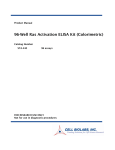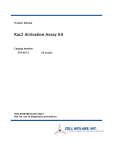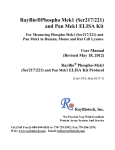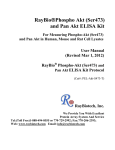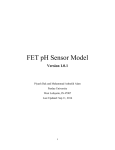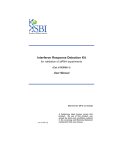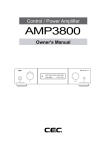Download 96-Well Ras Activation ELISA Kit (Chemiluminescent)
Transcript
Product Manual 96-Well Ras Activation ELISA Kit (Chemiluminescent) Catalog Number STA-441 96 assays FOR RESEARCH USE ONLY Not for use in diagnostic procedures Introduction Small GTP-binding proteins (or GTPases) are a family of proteins that serve as molecular regulators in signaling transduction pathways. Ras, a 21 kDa protein, regulates a variety of biological response pathways that include cell growth, cell transformation and tumor invasion. Like other small GTPases, Ras regulates molecular events by cycling between an inactive GDP-bound form and an active GTPbound form. In its active (GTP-bound) state, Ras binds specifically to the Ras-binding domain (RBD) of Raf-1 to control downstream signaling cascades. The most notable members of the Ras subfamily are H-Ras, N-Ras and K-Ras, mainly for being implicated in many types of cancer. Cell Biolabs’ 96-well Ras Activation ELISA Kit utilizes plate-bound, Raf-1 RBD to selectively isolate and pull-down the active forms of Ras (H-, K-, and N-Ras isoforms from human, mouse and rat) from purified samples or endogenous lysates. Subsequently, the captured GTP-Ras is detected by an Antipan-Ras Antibody and HRP conjugated secondary antibody. Finally, following the addition of Chemiluminescent Reagent, the reaction is then measured in a plate luminometer. Cell Biolabs’ 96-well Ras Activation ELISA Kit provides a simple and fast tool to monitor the activation of Ras. Each kit provides sufficient reagents to perform up to 96 assays. Related Products 1. STA-400-H: H-Ras Activation Assay Kit 2. STA-400-K: K-Ras Activation Assay Kit 3. STA-400-N: N-Ras Activation Assay Kit 4. STA-401-1: Rac1 Activation Assay Kit 5. STA-402: Cdc42 Activation Assay Kit 6. STA-403-A: RhoA Activation Assay Kit 7. STA-410: Raf-1 RBD Agarose Beads 8. STA-440: 96-well Ras Activation ELISA Kit (Colorimetric) 9. STA-457: Ras Expression Vector Set 10. STA-459: Active Ras Expression Vector Set Kit Components Box 1 (shipped at room temperature) 1. Raf-1 RBD Capture Plate (Part No. 244101): One solid, white 96-well plate. 2. 5X Assay/Lysis Buffer (Part No. 240102): One 30 mL bottle of 125 mM HEPES, pH 7.5, 750 mM NaCl, 5% NP-40, 50 mM MgCl2, 5 mM EDTA, 10% Glycerol. 3. Assay Diluent (Part No. 310804): One 50 mL bottle. 4. 10X Wash Buffer (Part No. 310806): One 100 mL bottle. 5. Chemiluminescent Reagent A (Part No. 250102): One 6 mL amber bottle. 2 6. Chemiluminescent Reagent B (Part No. 250103): One 6 mL bottle. 7. Plate Sealing Films (Part No. 244102): One pack of two sealing films. Box 2 (shipped on blue ice packs) 1. Raf-1 RBD (500X) (Part No. 244002): One 40 µL vial. 2. Anti-pan-Ras Antibody (1000X) (Part No. 244003): One 20 µL vial. 3. Secondary Antibody, HRP Conjugate (Part No. 244004): One 20 µL vial. 4. 100X GTPγS (Part No. 240103): One 50 µL vial of 10 mM GTPγS dissolved in sterile water. 5. 100X GDP (Part No. 240104): One 50 µL vial of 100 mM GDP dissolved in sterile water. Materials Not Supplied 1. Stimulated and non-stimulated cell or tissue lysates 2. Ras activators 3. Protease inhibitors 4. 0.5 M EDTA in water 5. 1 M MgCl2 6. 30°C incubator or water bath 7. Room temperature shaker 8. 10 µL to 1000 µL adjustable single channel micropipettes with disposable tips 9. 50 µL to 300 µL adjustable multichannel micropipette with disposable tips 10. Multichannel micropipette reservoir 11. 96-well Plate Luminometer Storage Upon receipt, aliquot and store Raf-1 RBD at -80ºC and avoid freeze/thaw. Aliquot and store the Antipan-Ras Antibody, Secondary Antibody, GTPγS, and GDP components at -20ºC and avoid freeze/thaw. Store all other components at 4ºC until their expiration dates. Preparation of Reagents • 1X Assay/Lysis Buffer: Mix the 5X stock briefly and dilute to 1X in deionized water. Just prior to usage, add protease inhibitors such as 1 mM PMSF, 10 μg/mL leupeptin, and 10 μg/mL aprotinin. • 1X Wash Buffer: homogeneity. • Anti-pan-Ras Antibody: Immediately before use dilute the Anti-pan-Ras Antibody 1:1000 with Assay Diluent. Do not store diluted solutions. • Secondary Antibody, HRP Conjugate: Immediately before use dilute the Secondary Antibody, HRP Conjugate 1:2500 with Assay Diluent. Do not store diluted solutions. Dilute the 10X Wash Buffer to 1X with deionized water. 3 Stir to • Chemiluminescent Reagent: Immediately before use, mix equal volumes of Chemiluminescent Reagent A with Chemiluminescent Reagent B. Do not store diluted solutions. Preparation of Samples Note: It is advisable to use fresh cell or tissue lysates because GTP-Ras is quickly hydrolyzed to GDP-Ras; frozen lysates stored at -70°C may be used. Performing steps at 4°C or on ice may reduce hydrolysis. Avoid multiple freeze/thaw cycles of lysates. I. Adherent Cells 1. Culture cells to approximately 80-90% confluence. Stimulate cells with Ras activator(s) as desired. 2. Aspirate the culture media and wash twice with ice-cold PBS. 3. Completely remove the final PBS wash and add ice-cold 1X Assay/Lysis Buffer to the cells (0.5 - 1 mL per 100 mm tissue culture plate). 4. Place the culture plates on ice for 10-20 minutes. 5. Detach the cells from the plates by scraping with a cell scraper. 6. Transfer the lysates to appropriate size tubes and place on ice. 7. If nuclear lysis occurs, the cell lysates may become very viscous and difficult to pipette. If this occurs, lysates can be passed through a 27½-gauge syringe needle 3-4 times to shear the genomic DNA. 8. Clear the lysates by centrifugation for 10 minutes (14,000 x g at 4°C). 9. Collect the supernatant and store samples on ice for immediate use, or snap freeze samples and store at -70°C for future use. 10. Proceed to GTPγS/GDP Loading for positive and negative controls, or the Activation ELISA (Assay Protocol Section). II. Suspension Cells 1. Culture cells and stimulate with Ras activator(s) as desired. 2. Perform a cell count, and then pellet the cells by centrifugation. 3. Aspirate the culture media and wash twice with ice-cold PBS. 4. Completely remove the final PBS wash and add ice-cold 1X Assay/Lysis Buffer to the cell pellet (0.5 – 1 mL per 1 x 107 cells). 5. Lyse the cells by repeated pipetting. 6. Transfer the lysates to appropriate size tubes and place on ice. 7. If nuclear lysis occurs, the cell lysates may become very viscous and difficult to pipette. If this occurs, lysates can be passed through a 27½-gauge syringe needle 3-4 times to shear the genomic DNA. 8. Clear the lysates by centrifugation for 10 minutes (14,000 x g at 4°C). 4 9. Collect the supernatant and store samples on ice for immediate use, or snap freeze samples and store at -70°C for future use. 10. Proceed to GTPγS/GDP Loading for positive and negative controls, or the Activation ELISA (Assay Protocol Section). Assay Protocol I. GTPγS/GDP Loading (Positive and Negative Controls) Note: Samples that will not be GTPγS/GDP loaded may be kept on ice during preparation of GTPγS/GDP loading samples. 1. Aliquot 0.5 mL of each cell lysate to two microcentrifuge tubes. Note: Typical protein concentration of sample is > 0.5 mg/mL. 2. Add 10 µL of 0.5 M EDTA to each sample. 3. Add 5 µL of 100X GTPγS to one tube (positive control) and 5 µL of 100X GDP to the other tube (negative control). Mix and label each tube appropriately. 4. Incubate the tubes for 30 minutes at 30°C with agitation. 5. Stop the loading by adding 33 µL of 1 M MgCl2 to each tube. Mix and place tubes on ice. 6. Continue with the Activation ELISA. II. Ras Activation ELISA Note: Samples and controls should be thawed/maintained on ice just prior to use (Step 3). 1. Determine the number of wells to be used, and dilute the Raf-1 RBD 1:500 in Assay Diluent. Add 100 µL of the diluted Raf-1 RBD to each well of the Raf-1 RBD Capture Plate. Incubate at room temperature for 1 hour on an orbital shaker. Cover unused wells with a plate sealing film. Note: Do not store diluted solutions. 2. Wash microwell strips 3 times with 250 µL 1X Wash Buffer per well with thorough aspiration between each wash. After the last wash, empty wells and tap microwell strips on absorbent pad or paper towel to remove excess 1X Wash Buffer. 3. Add 50 µL of Ras lysate sample (10-100 µg), control, or buffer blank per well. Each sample should be assayed in duplicate. Any sample dilutions should be performed in cold, 1X Assay/Lysis Buffer. 4. Immediately add 50 µL of Assay Diluent to each well (100 µL total volume). Incubate at room temperature for 1 hour on an orbital shaker. 5 5. Wash microwell strips 5 times with 250 µL 1X Wash Buffer per well with thorough aspiration between each wash. After the last wash, empty wells and tap microwell strips on absorbent pad or paper towel to remove excess 1X Wash Buffer. 6. Add 100 µL of the diluted Anti-pan-Ras Antibody to each well. Incubate at room temperature for 1 hour on an orbital shaker. 7. Wash the strip wells 5 times according to step 5 above. 8. Add 100 µL of the diluted Secondary Antibody, HRP Conjugate to each well. Incubate at room temperature for 1 hour on an orbital shaker. 9. Wash the strip wells 5 times according to step 5 above. Proceed immediately to the next step. 10. Add 100 µL of Chemiluminescent Reagent (see Preparation of Reagents Section) to each well, including the blank wells. Incubate at room temperature for 5 minutes on an orbital shaker. 11. Read the luminescence of each microwell on a plate luminometer. 6 Example of Results The following figure demonstrates typical results seen with Cell Biolabs 96-well Ras Activation ELISA Kit. One should use the data below for reference only. Figure 1: EGF Stimulation. HeLa cells were serum starved for 18 hours before EGF stimulation (50 ng/mL for 2 minutes). Lysates were then prepared according to Assay Protocol. Background has been subtracted from data. Figure 2: Pan-Ras Antibody Specificity. Anti-pan-Ras Antibody specificity to purified, H-, K-, and N-Ras human isoforms by dot blot. References 1. Bar-Sagi D., and Hall A. (2000) Cell 103: 227-38. 2. de Rooij J., and Bos J. L. (1997) Oncogene 14: 623-5. 7 Warranty These products are warranted to perform as described in their labeling and in Cell Biolabs literature when used in accordance with their instructions. THERE ARE NO WARRANTIES THAT EXTEND BEYOND THIS EXPRESSED WARRANTY AND CELL BIOLABS DISCLAIMS ANY IMPLIED WARRANTY OF MERCHANTABILITY OR WARRANTY OF FITNESS FOR PARTICULAR PURPOSE. CELL BIOLABS’ sole obligation and purchaser’s exclusive remedy for breach of this warranty shall be, at the option of CELL BIOLABS, to repair or replace the products. In no event shall CELL BIOLABS be liable for any proximate, incidental or consequential damages in connection with the products. Contact Information Cell Biolabs, Inc. 7758 Arjons Drive San Diego, CA 92126 Worldwide: +1 858-271-6500 USA Toll-Free: 1-888-CBL-0505 E-mail: [email protected] www.cellbiolabs.com 2013: Cell Biolabs, Inc. - All rights reserved. No part of these works may be reproduced in any form without permissions in writing. 8








